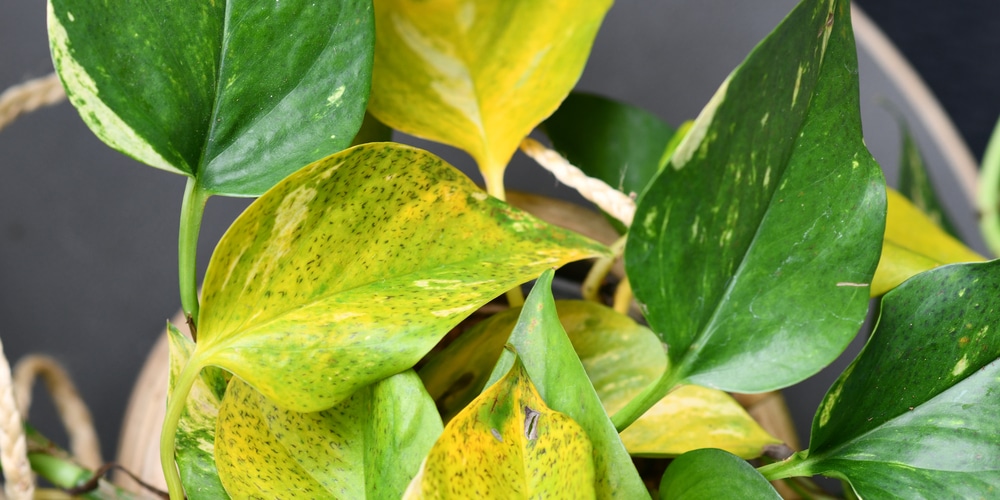Pothos is a common houseplant that is available in different varieties and colors. It is very popular for its adaptability and because it’s easy to care for. However, sometimes pothos leaves turn yellow even when there is no change in care. There are several possible reasons for this. The best advice is to consider these possibilities before diagnosing the plant with a disease or nutrient deficiency. Let’s look at why pothos leaves turn yellow.
Why Pothos Leaves Turn Yellow?

Here are the most common reasons your pothos plants leaves may have started to discolor and turn yellow.
Mineral Deposits in Soil
When a lot of fertilizer is left in the potting soil over a long period of time, a build-up of mineral salts may occur that blocks the absorption of nutrients by the roots. Overwatering or using hard water will also increase the chances for this to happen. In this case, check your fertilizer routine and consider repotting your pothos into fresh potting soil with added compost. Pothos prefers the soil to have a pH range of between 6.1 and 6.5.
Insufficient Nutrition
Sometimes pothos leaves turn yellow simply because they are not getting enough nutrients from the soil. In that case, repotting into fresh soil with compost is advised. The plant may have developed a deficiency or an imbalance in nutrients.
Too much Sun
Don’t leave your pothos plant in the full sun, or the leaves may start to discolor. Sunburn causes leaves to turn yellow and brown patches will form. Always place your pothos in indirect light or partial shade.
Incorrect temperature
Pothos are tropical plants that don’t like cold temperatures. They should only be grown outdoors year-round in USDA zones 10 and 11. Be careful not to leave your plant outside if frost is expected, as the cold will turn leaves yellow and may kill your plant. It’s recommended not to leave your plant in temperatures of less than 55F. If your pothos has been left in a draught from an open window or the air conditioning, it could also cause leaves to discolor.
Spider Mites
If the yellowing leaves are accompanied by webby growth on leaf undersides, it means that your pothos is infested with spider mites. If you do not take immediate action to get rid of them, they can completely damage your plant and spread to other indoor plants in the house.
Spider mites or other sap-sucking insects such as mealybugs or aphids can affect pothos plants. They usually appear during hot summer months when temperatures are high. To combat insect infestations, use an insecticidal spray or wipe your plant down with neem oil.
Fungal Infections
Pothos like other members of the Epipremnum genus is often susceptible to root rot caused by fungal infections or overwatering. Fungi enter through the roots and cause the plant’s cells to break down until they have been completely consumed from within. In addition to yellow leaves, which become fragile and begin to drop off, you may notice water-soaked lesions on lower stems during humid weather conditions due to water accumulating inside the lesions.
To remedy this condition, remove your pothos from any containers that are not well-drained and cut off any affected stems below the point of damage. You can also cut off roots that look black and feel soggy. Treat your plant with a fungicide.
However, even if you have taken all these steps, your plant may still die because once the fungi has gained entry into a plant’s tissues, it can spread to other plants in your home through soil contact. Throw away any infested plants to prevent the disease from spreading throughout your house.
Overwatering
Proper watering is essential to avoid fungal diseases that attack the entire plant from within, causing leaves to yellow and drop off. Overwatering can cause pothos to become stunted with pale green leaves because the roots will not be able to get enough air from the soil.
In addition to stunted growth due to lack of oxygen in the soil, your pothos may develop root rot if you keep it in waterlogged conditions for too long because fungal pathogens prefer wet environments.
To prevent this condition, ensure that excess water drains out thoroughly after watering. Don’t let your plant become submerged in standing water. One way to tell if your pothos needs watering is by gently feeling the soil to see whether it has become dry. Use a finger to poke down into the soil up until the second knuckle. If moisture can be felt on your fingertip when removing it, do not water just yet because the ground is still wet.
Conclusion
If you have discovered that your pothos leaves are yellowing, follow the above steps to address the condition’s underlying cause. Pothos is an easy-to-care-for plant because its tolerant of various levels of sunlight exposure.